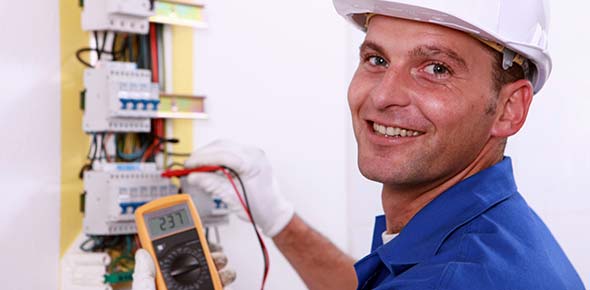Before working on an electrical system, you always should
To prevent others from tampering with switches, you will
Before testing and sounding audible signal in fire alarm circuit, you...
Normally, an across-the-line motor control incoporate some type of
The internal winding of all three-phase motors are
A motor that operates slowly may have a
What type of grease should you use when you lubricate switches and...
According to the NEC, the wiring for emergency lighting system must be
The component of a three-phase motor connected to the load is the
The magnetic field of a three-phase motor rotor is caused by
Emergency lights are powered by
The electric range produces heat by
What is the first step in troubleshooting an appliance
The DC shunt motor connects the field coils and armature in
The conductor common to both the starting and holding circuits is...
What part of a three-phase motor is connected to the supply voltage?
Which motor would have the highest rpm if each were connected to the...
The squirrel-cage winding has high-inductive reactance and is placed...
The basic types of overload relays are
What type of process is corrosion?
In a DC motor, how are coil ends from the amature winding...
To prevent explosive materials from passing from one part of an...
The most common appliance repairs made are to motors, switches, and
The DC motor with the highest starting torque is the
Where should fire alarm reference material be maintained?
A centrifugal switch is used in a single-phase motor to
The bulb normall used with incandescent emergency lights is a
The purpose of the motor on a siren for a base warning system is to...
What should be your first check on a motor that seems to be...
The motor that requires some starting means is the
An indication of an open rotor in a squirrel-cage motor is
An above-normal potential between the half -cell electrode and the...
What is the most desirable water heater temperature control setting...
What type of motor enclosure is designed to prevent liquids or solids...
Which organization is responsible for turning on the base warning...
To prevent steel or cast-iron structures, what should the voltage...
If work must be done on equipment exposed to hazardous material, the...
What are cathodic protection test stations?
Which fire alarm system provides an audible, visual, or combination of...
Electrical equipment used in class 1 locations must be
The two classification of fire alarm systems are the local and
A signal head may have a maximum of how many signal faces?
What is the minimum mounting clearance required for the signal head?
How many basic types of across-the-line motor control are there?
How often should a total discharge of emergency -light batteries and...
The controller operates loop and lead-in system whose total inductance...
How often does an installation usually test its base warning system?
When you work in a class 1 hazardous location, you should use all the...
What are te standard size for signal lenses?
Most repairs made in the controller cabinet of a traffic control...
A woodworking shop would constitute what class of electrical hazard?
The most common type of detectors for traffic controls are
What should you connect to operate a single-phase dual-voltage...
Motor voltage must be within what percent of the voltage rating
Your first step in troubleshooting the base warning system should be...
Where does stray current corrosion cause greatest damage?
How many basic forms of corrosion control by cathodic protection are...
What component inside the JSIIDS control unit is designed for fast,...
The end ply of a motor should not exceed
How many basic forms of "normal" corrosion are there?
The method used to open the contacts on an across-the -line magnetic...
Which of the following do you use on a traffic control system?
When troubleshooting fire alarm system, where do the most frequent...
At least how many inches of backfill should extend from each end of...
If you check a heating element and the Ohmmeter reads "0" Ohms, the...
How often must you maintain AF Form 491, Cathiodic Protection...
After the initial level of cathodic protection of a galvanic anode...
What is the basic unit of conductivity for water resistivity?
How often should a structure checked for depth of pitting?
The controller on a base warning system is located
The ions that leave the metal and enter into solution are
Sparkproof electrical equipment must be used in what class lacations?
What is the main notification equipment of the JSIIDS?
















